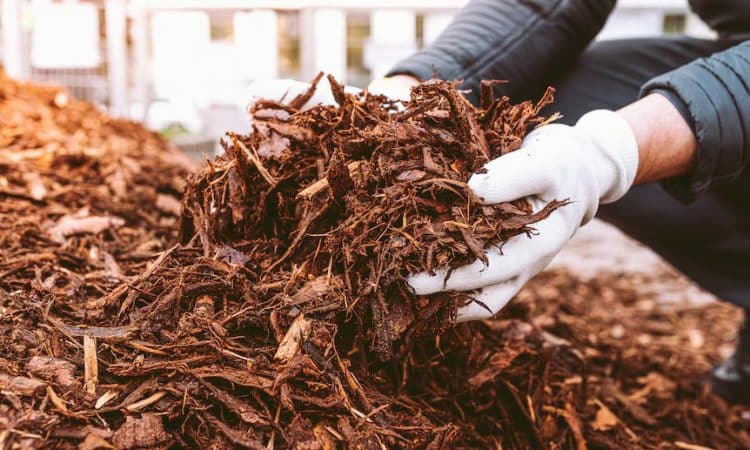
There’s nothing quite like showing your garden some TLC, and mulching is one of the easiest ways to do it! Not only does mulching make your garden look great, but it also has a whole host of benefits. So, what are you waiting for? Get your hands dirty and start mulching today!
Why do we mulch our gardens?
Applying mulch to a garden delivers several benefits, and as Gardening Australia senior researcher Patrick Honan explains: “It’s almost the first port of call if you’re making or wanting to improve a garden.”
One of the main purposes of mulching is to insulate the soil around plants and trees to help protect them exposure to the elements, including ultraviolet radiation and wind, and prevent excessive water evaporation.
“Mulch will keep water in the soil for longer, so you have to water less,” Mr Honan says.
It can also add nutrients to the soil and can help boost the biodiversity of your garden.
“A lot of urban soils are sterile and if you put mulch on there, it means things like little bugs, sliders and worms can start to find a place to live and then eventually live in the soil and as the mulch breaks down, it contributes organic matter to the soil, provided it’s made from something organic, like a wood chip.”
Choosing the right mulch for your garden
There are several different varieties of mulch but broadly speaking, they fall into two categories: organic and inorganic.
Organic mulches are derived from living materials, generally plant matter such as wood chips, bark, sugar cane, straw and hay.
Deciding which type is best for your garden depends on what you’re applying it to. Lighter varieties such as hay, pea straw and sugarcane mulch work well for veggie gardens.
“Those mulches don’t last a very long time, but they can be a good option, because they’re quite fine, they’re cheap, and they’re easy to move around, so they’re good for vegetables and annual crops,” Mr Honan says.
Light mulches are also a good option if you’re planting seeds, as they will help trap moisture and provide a fine protective layer but still allow things to grow.
Wood chips are the best option for long-term ornamental plantings or fruit trees. These can include anything from what’s commonly referred to as forest mulch to plantation pine chips.
“Generally, what I recommend is what’s called arborist clippings and that’s just what local arborists in the area have been cutting down and then chipping up. Usually it’s pretty coarse and if it’s not free, it’s very, very cheap to get it in bulk,” Mr Honan says.
Inorganic mulches are usually stone products such as polished river stone, white pebbles, crushed brick, or scoria (a porous, igneous rock).
“They’re going to be there forever, obviously, but they don’t hold any moisture and they don’t break down over time, so they’re not improving the soil,” Mr Honan says.
That said, they can be a desirable option for arid gardens, particularly if it’s white stone, which will reflect heat back up into the plants.
“If you’ve got heat-loving plants like cacti and succulents, that’s kind of the preferred treatment because they don’t actually like the humidity that a woodchip mulch will provide, because they naturally grow in stony desert environments.”
When is the best time to mulch?
Although you can mulch all year round, the best time to apply it to your garden is at the beginning of the growing season, typically in spring, but that can differ depending on whereabouts you live, as Mr Honan explains.
“In Melbourne, the classic thing is you want to put pea straw or similar around your annual vegetable crops. But I don’t like doing that until it starts to get a little bit later in the season because slugs and snails love to breed in it when it stays wet in early spring, and then when I’m planning out my spring vegetables they’re just getting dominated by slugs,” he says.
“I know in Tasmania they have to push it even further because obviously it’s colder … so some people down there prefer to keep no mulch on for a longer period of time so that there’s space for the sun to come and heat up the soil.”
Other mulching tips
It’s a good idea to wear personal protective equipment (PPE) such as face masks and safety glasses or sunglasses when mulching.
When mulching around trees and plants, it’s important to create a crater or well around the base of trees and plants.
“If someone’s laid mulch to the trunk of a tree and then mounded it right the way up the tree … you’ll get fungus that will basically kill the tree,” Mr Honan says.
You should also keep the depth of your mulch to a maximum of about 70 millimetres, as anything deeper can prevent water from reaching the soil.
Sourcing your mulch locally is usually the most cost-effective option and also means it’s more likely to be comprised of plants and organic matter that’s native to your area.
Some organic mulches can attract termites, especially in more humid areas, but some varieties such as cypress and tea tree mulches, are said to contain natural repellents.
“I know [termites] is something that people in Brisbane in particular think about in terms of moisture,” Mr Honan says.
To avoid contamination, source your mulch from a reputable source. That should mean it meets Australian industry standard.
“Look at it before you accept it, and make sure that there’s nothing you don’t want in there,” Mr Honan says.

